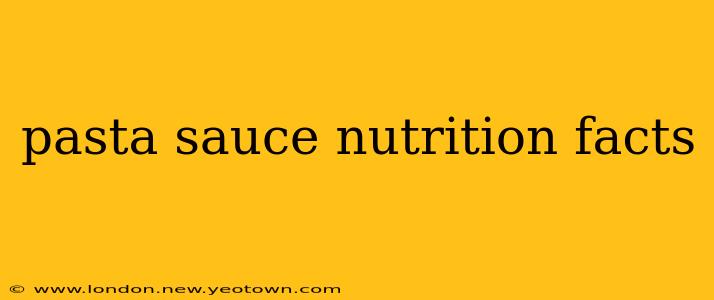Ah, pasta sauce! The vibrant heart of countless comforting meals, from simple spaghetti dinners to elaborate lasagna masterpieces. But beyond its deliciousness lies a nutritional landscape worth exploring. This isn't just about calories; it's about understanding the vitamins, minerals, and potential health impacts of this culinary staple. Let's unravel the nutritional secrets hidden within those jars and cans.
What are the nutritional benefits of pasta sauce?
This is where the story gets interesting. The nutritional profile of pasta sauce varies wildly depending on the type. A simple tomato-based sauce, brimming with fresh tomatoes, garlic, and herbs, offers a fantastic source of lycopene, a powerful antioxidant linked to reduced cancer risk and heart health. Tomatoes are also packed with vitamin C and potassium. Adding vegetables like onions, peppers, and carrots boosts the vitamin and mineral content even further, introducing vitamin A, vitamin K, and various other beneficial compounds.
However, the nutritional value can take a tumble with added ingredients. Creamy sauces, laden with cream or butter, are significantly higher in fat and calories. Ready-made sauces, often containing added sugars, salt, and preservatives, might compromise the overall health benefits. The key is to choose wisely and be aware of what's in your sauce.
How many calories are in a serving of pasta sauce?
This question is tricky, as the calorie count dramatically fluctuates based on the type and serving size. A half-cup serving of a simple tomato-based sauce might clock in around 25-40 calories, whereas a richer, cream-based sauce could easily surpass 100 calories. Always check the nutrition label on the specific jar or can for accurate calorie information. Remember, calorie density varies considerably – a small amount of a very rich sauce can pack a surprising caloric punch.
What are the ingredients in pasta sauce?
The beauty (and sometimes the downfall) of pasta sauce lies in its versatility. The simplest versions boast just tomatoes, herbs, and spices. From there, the ingredient list can expand dramatically. Common additions include garlic, onions, peppers, mushrooms, olives, and various herbs and spices. More commercially produced sauces, however, may include added sugars, salt, thickeners, preservatives, and even artificial flavorings.
Is pasta sauce good for weight loss?
This depends heavily on the type of pasta sauce you choose and how you incorporate it into your diet. A simple, low-calorie tomato-based sauce can be a wonderful addition to a weight-loss-friendly meal plan. The fiber content in tomatoes can promote satiety, helping you feel fuller for longer. However, creamy sauces or those loaded with added sugars and unhealthy fats are not ideal for weight loss. Mindful portion control and careful ingredient selection are key.
How can I make healthy pasta sauce?
Making your pasta sauce from scratch is the ultimate way to control ingredients and nutritional content. Start with fresh, ripe tomatoes (or high-quality canned tomatoes), and add your favorite herbs, spices, and vegetables. Experiment with different combinations – roasted red peppers, sun-dried tomatoes, or even a touch of balsamic vinegar can add depth of flavor and nutritional benefits. Avoid excessive salt and added sugars, relying instead on the natural flavors of the ingredients.
Does pasta sauce contain sugar?
Many commercially produced pasta sauces contain added sugar, often to enhance flavor and balance acidity. The amount varies greatly depending on the brand and type of sauce. Check the nutrition label carefully, and consider opting for low-sugar or no-sugar-added options if you're watching your sugar intake. Making your own sauce is the best way to ensure you control the sugar content.
In conclusion, pasta sauce, while undeniably delicious, offers a nutritional landscape as varied as its flavors. By understanding the nutritional composition of different sauce types and making informed choices, you can enjoy this culinary staple guilt-free as part of a balanced diet. Remember to always read the nutrition labels and opt for fresh, whole ingredients whenever possible. Happy cooking!

